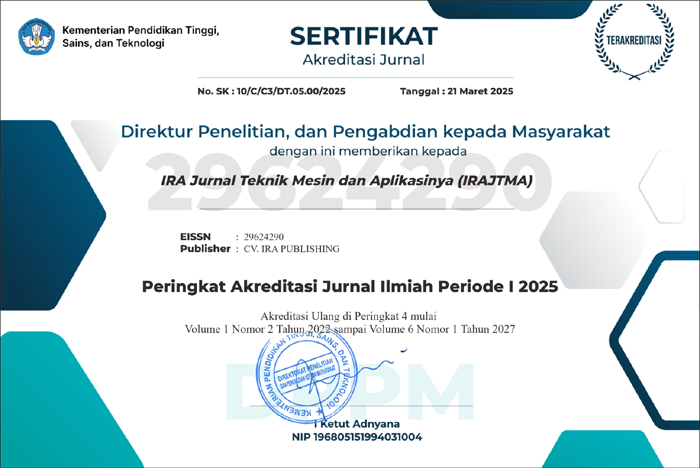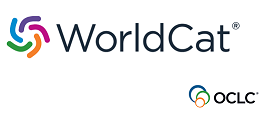The Effect of Cutting Speed on The Surface Roughness of AISI 1018 Steel in the Dry Turning Process
DOI:
https://doi.org/10.56862/irajtma.v4i2.209Keywords:
Cutting speed, Surface roughness, AISI 1018 steel, Turning process.Abstract
Cutting speed is one of the crucial parameters in the turning process that significantly affects the final quality of the workpiece surface. This study aims to evaluate the impact of cutting speed variations on the surface roughness level of AISI 1018 steel. The machining process was carried out using a chisel with a tip radius of 1.2mm, and the cutting speed was varied at three levels, namely 42m/min, 66m/min, and 105m/min. Surface roughness measurements were carried out using a Surface Roughness Tester. The experimental results showed that increasing cutting speed tended to decrease surface roughness. The lowest roughness value of 2.224 μm was obtained at a cutting speed of 105 m/min. This phenomenon occurs because at higher cutting speeds, cutting forces and vibrations are reduced, so that the machining process becomes more stable and produces better surface quality. This study shows that cutting parameters play an important role in optimizing the final results of conventional turning processes.
References
Akhmadi, Amin Nur, Mukhamad Khumaidi Usman, dan Firman Lukman Sanjaya. 2024. “Pengaruh Kecepatan Putaran dan Pemakanan terhadap Permukaan Baja ST 41 pada Mesin Bubut.” IRA Jurnal Teknik Mesin dan Aplikasinya (IRAJTMA) 3 (3): 31–41. https://doi.org/10.56862/irajtma.v3i3.157.
Arsana, P., I. P. Nugraha, dan K. R. Dantes. 2019. “Pengaruh Variasi Media Pendingin terhadap Kekasaran Permukaan Benda Kerja Hasil Pembubutan Rata pada Baja ST. 37.” Jurnal Pendidikan Teknik Mesin Undiksha 7 (1): 7–17. https://doi.org/10.23887/jjtm.v7i1.18746.
Elvan, E., M. S. Y. Lubis, dan S. Darmawan. 2025. “Strength Analysis of Tig Welding Joints on KMHE Car Roll Bars Using 6061 Aluminum Through Bending Tests.” IRA Jurnal Teknik Mesin dan Aplikasinya (IRAJTMA) 4 (1): 69–75. https://doi.org/10.56862/irajtma.v4i1.203.
Fahrizal. 2022. “Optimasi Parameter Pemesinan untuk Minimasi Keausan Pahat pada Pembubutan Baja Karbon Rendah.” Jurnal Pendidikan Teknik Mesin Undiksha 10 (1): 10–19. https://doi.org/10.23887/jptm.v10i1.41418.
Husni, Tarmizi, Ridwan Hadi, Gani Hasibuan, dan Riki Siregar. 2020. “Pengaruh Jenis Pahat dan Kedalaman Pemakanan pada Proses Pembubutan terhadap Kekasaran Permukaan AISI 4340.” Teknika: Jurnal Teknik 6 (2): 119–33. http://dx.doi.org/10.35449/teknika.v6i2.110.
Lubis, Muhammad Sobron Yamin, Steven D., Alfred Briantio, dan Rosehan Rosehan. 2023. “Penentuan Parameter Pemotongan Optimal Proses Milling terhadap Kekasaran Permukaan Baja SKD11 dengan Metode Taguchi.” IRA Jurnal Teknik Mesin dan Aplikasinya (IRAJTMA) 1 (3): 44–50. https://doi.org/10.56862/irajtma.v1i3.33.
Prasetyo, H., dan R. Andika. 2020. “Pengaruh Cutting Speed terhadap Kekasaran Permukaan pada Proses Pembubutan Baja Karbon Rendah.” Jurnal Teknik Mesin Nusantara 8 (2): 45–52.
Putra, F., dan T. Nugroho. 2023. “Surface Finish Quality Improvement by Varying Cutting Speed in Turning Process.” Journal of Advanced Manufacturing Technology 9 (1): 56–63.
Rumbiak, A. S., H. S. Putra, M. S. Y. Lubis, dan E. Siahaan. 2025. “The Influence of Feed Rate in the Milling Process of SKD 61 Steel on Wear of 2-Flute Carbide Endmill.” IRA Jurnal Teknik Mesin dan Aplikasinya (IRAJTMA) 4 (1): 32–38. https://doi.org/10.56862/irajtma.v4i1.189.
Siregar, A., dan S. Hadi. 2022. “Optimization of Cutting Parameters for AISI 1018 Using Taguchi Method.” Journal of Mechanical Engineering Science and Technology 6 (3): 101–8.
Sukoco, E., dan Y. Ananda. 2019. “Studi Eksperimental Kekasaran Permukaan terhadap Variasi Parameter Pemotongan.” Jurnal Riset Manufaktur 5 (1): 33–40.
Wijaya, D., dan M. Rahman. 2021. “Experimental Study on Surface Roughness Using Carbide Inserts in Dry Turning.” International Journal of Mechanical Engineering Innovation 4 (2): 23–31.
Downloads
Published
How to Cite
Issue
Section
License
Copyright (c) 2025 IRA Jurnal Teknik Mesin dan Aplikasinya (IRAJTMA)

This work is licensed under a Creative Commons Attribution-ShareAlike 4.0 International License.

















